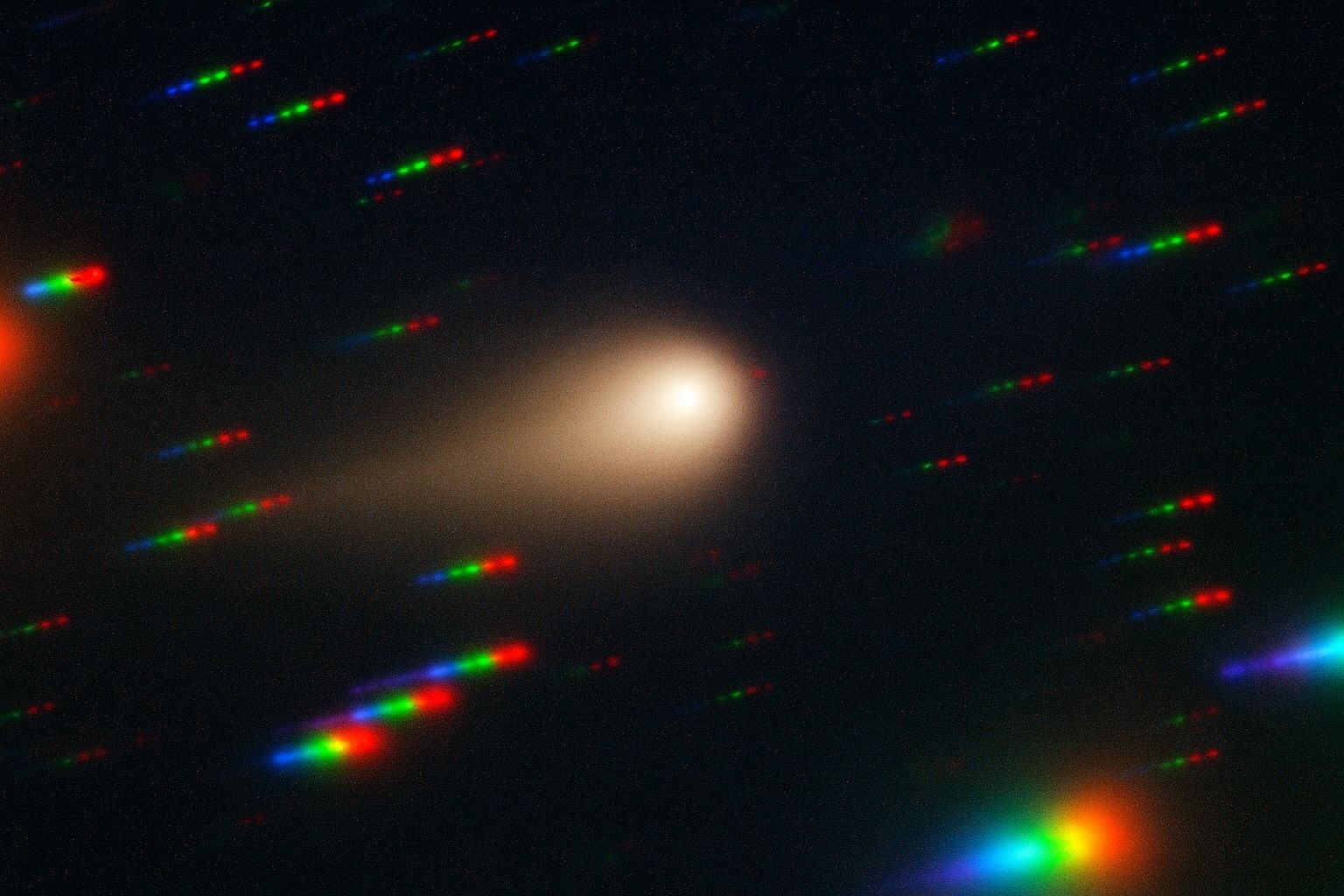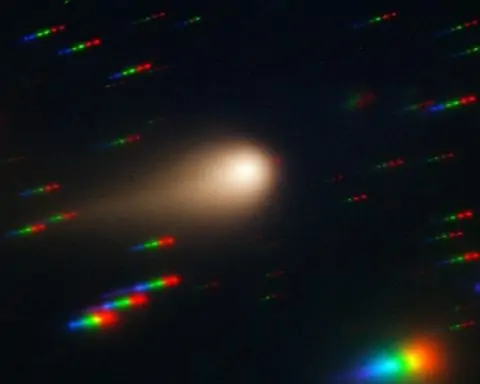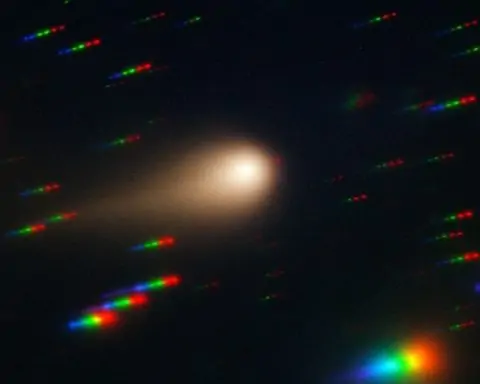Key Facts and Highlights
- Third Interstellar Visitor: Comet 3I/ATLAS is only the third known object from beyond our solar system (after 2017’s 1I/‘Oumuamua and 2019’s 2I/Borisov) [1]. Discovered July 1, 2025 by the NASA-funded ATLAS survey in Chile, its unbound hyperbolic trajectory immediately flagged it as interstellar [2].
- Close Solar Approach (Oct 29–30, 2025): It reached perihelion (closest point to the Sun) around October 29, 2025, coming inside Mars’ orbit at ~1.36 AU from the Sun [3]. At perihelion it lay on the far side of the Sun from Earth, so it was unobservable from Earth then. Its closest approach to Earth will be ~1.8 AU (270 million km) in December 2025, posing no threat and remaining too faint for the naked eye [4].
- Blazing Speed: 3I/ATLAS is hurtling through the inner solar system at 58 km/s (~130,000 mph) [5] – an extraordinary speed far above typical comet velocities. Its extreme velocity and open, escape trajectory are clear signatures of an interstellar origin [6].
- Record Size: Astronomers believe 3I/ATLAS may be the largest interstellar object detected so far. Early observations hinted its icy nucleus could be up to a few kilometers wide [7] – far bigger than ‘Oumuamua (~100 m) or Borisov (~1 km). Hubble imaging set an upper limit around 5.6 km diameter [8], making 3I/ATLAS potentially a giant among interstellar wanderers.
- Ancient “Time Capsule”: Based on its galactic trajectory, 3I/ATLAS likely hails from the Milky Way’s ancient thick disk population of stars [9]. Researchers estimate it could be 7–11 billion years old, possibly the oldest comet ever observed (about 3 billion years older than our 4.6 billion-year-old solar system) [10]. In other words, this comet may have formed long before our Sun, preserving primordial material from a bygone cosmic era [11].
- Unusual Activity: Even far from the Sun, 3I/ATLAS has been surprisingly active. NASA’s Swift space telescope detected it spewing water vapor at ~40 kg per second – “approximately the equivalent of a firehose at full power” – while still 2.9 AU from the Sun [12]. Such copious water outgassing at three times Earth’s distance is highly unusual, suggesting volatile ice exposed early [13].
- Odd Composition: Spectra reveal 3I/ATLAS’s coma (gas halo) is rich in CO₂ but low in CO [14], meaning it “was well baked and boiled” in its original system and lost its most volatile ices long ago [15]. Scientists also detected cyanide gas and an unexpected abundance of nickel vapor in the comet’s gas [16]. Nickel is rarely seen in comets at such distances; researchers suspect it may be carried in the form of nickel tetracarbonyl, a volatile nickel-carbon monoxide compound that breaks apart under sunlight [17]. This bizarre chemistry is offering new clues to 3I/ATLAS’s makeup and interstellar journey.
- Global Observation Campaign: Telescopes worldwide – and off-world – have mobilized to study 3I/ATLAS. Both Hubble and the James Webb Space Telescope have observed it [18]. Large ground observatories (Gemini South, VLT, etc.) have imaged its coma and tail. Even spacecraft near other planets joined in: in early October, ESA’s ExoMars Trace Gas Orbiter snapped the comet from Mars orbit ~30 million km away [19] [20]. Coming up, ESA’s JUICE probe (near Jupiter) and NASA’s Psyche spacecraft (between Earth and Mars) are poised to observe 3I/ATLAS near perihelion from unique angles [21].
A Visitor From Beyond the Solar System
In July 2025, astronomers spotted a faint newcomer inbound toward the Sun – one that was not gravitationally bound to our star at all. The object, now designated 3I/ATLAS, is only the third interstellar visitor ever detected in our solar system [22]. (The “3I” prefix marks it as the third Interstellar object.) It was first observed on July 1, 2025 by the ATLAS sky-survey telescope in Río Hurtado, Chile, and its discovery immediately caused excitement. The reason? Its orbit was hyperbolic, meaning it’s not a periodic comet from our Oort Cloud but rather an interstellar interloper on a one-way trip through our cosmic neighborhood [23].
Previous interstellar objects – the enigmatic ‘Oumuamua in 2017 and comet 2I/Borisov in 2019 – were brief, tantalizing encounters. 3I/ATLAS offers scientists another rare chance to study a piece of a distant star system up close. “This is an object from a part of the galaxy we’ve never seen up close before,” noted astronomer Matthew Hopkins of Oxford, whose team predicted such thick-disk objects [24]. In fact, based on its galactic orbit, 3I/ATLAS may have originated in the Milky Way’s thick disk – a halo of ancient stars high above the galactic plane [25]. That would make it extraordinarily old. Statistical models suggest 3I/ATLAS is likely the oldest comet we have ever seen [26], potentially 7–10+ billion years in age, predating the formation of our solar system [27]. In essence, it’s a time capsule from an earlier epoch of the universe, now wandering through our Sun’s realm.
An Ancient Speedster on a One-Way Journey
Interstellar visitors don’t hang around. True to form, 3I/ATLAS is barreling through the inner solar system at about 58 km/s (over 210,000 km/h) relative to the Sun [28]. To put that in perspective, it’s moving roughly ten times faster than Earth’s orbital speed. Such velocity is necessary to escape the Sun’s gravity – and indeed 3I/ATLAS is on an open trajectory that will carry it straight back out into interstellar space after this flyby [29]. Tracing its path backward shows it came from far beyond the outermost reaches of the solar system [30]. In fact, NASA notes the comet approached from the direction of the constellation Sagittarius, toward the galaxy’s center [31], before the Sun’s gravity bent its course.
On October 29, 2025, 3I/ATLAS reached its closest point to the Sun (perihelion) at about 1.36 AU – just outside Earth’s orbit distance [32]. It actually swooped inside Mars’s orbit, coming about 203 million km from the Sun [33]. At perihelion the comet was only ~13° from the Sun as seen from Earth, hidden in solar glare [34]. Multiple solar-observing spacecraft kept eyes on it, though: e.g. NOAA’s GOES-19 satellite spotted 3I/ATLAS in its coronagraph imagery as a magnitude ~11 object near the Sun [35]. Thankfully, the comet survived its solar encounter and is now headed back outward. On its way out, it will make its closest pass by Earth on December 19, 2025 – but even then it remains a distant ~1.8 AU away (nearly twice the Earth–Sun distance) [36]. We have nothing to fear, as one astronomer quipped; this visitor will slip quietly past us into the void [37].
While rushing through the inner solar system, 3I/ATLAS has also been “meeting” some of our planets (at least in terms of orbital crossing). It already passed about 30 million km from Mars in early October, allowing ESA’s Mars orbiter to photograph it as a fuzzy dot [38] [39]. In early November it will pass ~0.65 AU from Venus, and it’s projected to come about 0.36 AU from Jupiter by March 2026 as it recedes [40]. These relatively distant flybys still offer unique observation geometry. For example, ESA’s JUICE (Jupiter Icy Moons Explorer) spacecraft will attempt to observe 3I/ATLAS in November 2025 just after perihelion [41]. JUICE’s cameras, spectrometers, and particle sensors will study the comet from afar, and ESA expects to receive data from that campaign by February 2026 [42] [43] [44]. This marks the first time multiple spacecraft around the solar system have coordinated to monitor an interstellar comet in real time – a testament to 3I/ATLAS’s scientific importance.
Unusual Features Reveal The Comet’s Secrets
Despite its interstellar mystique, 3I/ATLAS initially appeared comet-like in many ways: it sports a fuzzy coma of gas and dust and even developed a tail as sunlight warmed it [45]. Early on, astronomers noted it was “behaving like a comet” – outgassing vapors, brightening as expected, nothing obviously anomalous. However, as more data rolled in, some strange traits emerged that set 3I/ATLAS apart from ordinary comets.
One puzzle was the observation of an “anti-tail” – a tail appearing to point toward the Sun instead of away. In late summer 2025, some telescopic images showed a diffuse feature on the sunward side of the comet [46]. Normally, a comet’s dust and ion tails are pushed away from the Sun by solar radiation and the solar wind. So how could material stream toward the Sun? The likely explanation is a perspective effect: a thin dust trail along the comet’s orbit (sometimes called an anti-tail) became visible as the viewing geometry changed. Indeed, by September the anti-tail had flipped around to the normal orientation as the comet’s angle shifted [47]. Still, this quirk caught attention. It even fueled some imaginative theories (more on those later).
Perhaps the most intriguing discovery has been 3I/ATLAS’s chemical makeup. Observations by JWST (Webb) in August revealed a composition unusual compared to familiar comets: an outsized amount of carbon dioxide in the coma, a relatively small fraction of water ice, and surprisingly little carbon monoxide [48] [49]. In fact, one report noted the CO₂-to-water ratio is among the highest ever seen [50]. This suggests 3I/ATLAS’s ices have been heavily processed – possibly by eons of cosmic radiation or multiple close passes to stars – such that the more volatile ices (like CO) have long since evaporated, leaving behind less volatile CO₂ and water. “It was well baked and boiled,” as one scientist put it, losing its most volatile ingredients long ago [51]. This aligns with the idea that 3I/ATLAS is ancient and has traveled for billions of years through harsh interstellar space [52].
Another eye-opener was the detection of heavy elements and metals in the comet’s outgassing plume. Specifically, astronomers using the Very Large Telescope (VLT) in Chile found nickel vapor (Ni) and cyanide (CN) gas emanating from 3I/ATLAS [53]. Finding nickel at all is surprising – on Earth, nickel only vaporizes at extremely high temperatures. In the cold depths far from the Sun, metallic nickel should remain solid. So how is nickel appearing in the comet’s coma? Scientists propose it may hitch a ride in a molecular form. Nickel tetracarbonyl (Ni(CO)_4) is one candidate: a volatile nickel compound that can form when nickel and carbon monoxide combine, and which decomposes under UV light to release nickel atoms [54]. On Earth, nickel tetracarbonyl is known as an industrial byproduct (used in metal refining) – not something expected in space. Yet the presence of nickel gas hints that such exotic chemistry could be at play. In fact, spectral analysis did detect the telltale combination of nickel and carbon compounds consistent with Ni(CO)_4 [55] [56]. This is a first for any comet. It shows how other-star comets might contain chemical species we’ve never seen in our Solar System’s comets. Such data help researchers infer the conditions in 3I/ATLAS’s home environment. As one astronomer remarked, even these tiny traces of metal “provide new clues about the comet’s chemistry and its long interstellar voyage” [57].
Most dramatic is the comet’s level of activity. Even when it was nearly 3 AU (over 400 million km) from the Sun – roughly in Jupiter’s orbit – 3I/ATLAS was already outgassing large amounts of water. A team using NASA’s Neil Gehrels Swift Observatory detected hydroxyl (OH) – a breakdown product of water – indicating substantial water ice sublimation while the comet was still very far out [58]. In fact, it was losing water at about 40 kg per second at that distance [59]. The study’s authors compared this to a fire hydrant running full blast [60]. “Already at that distance, however, 3I/ATLAS was leaking water at a rate of about 40 kg/s, a flow comparable to that of a ‘hydrant at maximum power,’” reported Wired [61]. For context, typical comets don’t shed water so vigorously until they’re much nearer to the Sun’s heat. One possible explanation is that 3I/ATLAS’s nucleus could be fragmenting or shedding icy chunks, which then expose fresh ice that vaporizes even when relatively far from the Sun [62]. This behavior has only been seen in a few extreme comets. Whatever the cause, it means 3I/ATLAS offers a feast of data – its prodigious output of gas and dust makes it easier for telescopes to analyze its composition and behavior in detail.
Comparisons: How 3I/ATLAS Stacks Up to ‘Oumuamua and Borisov
Inevitably, 3I/ATLAS is being compared to its two interstellar predecessors, and the contrasts are fascinating. Each of the three known interstellar objects has been startlingly different, giving scientists three very distinct case studies of rogue visitors from afar.
1I/‘Oumuamua (2017) was the first-ever interstellar object detected. It was small (estimated just ~100–200 meters long), had an elongated or pancake-like shape, and notably displayed no visible coma or tail. It looked like a barren rock or perhaps a shard of something. ‘Oumuamua also showed a mysterious non-gravitational acceleration – as if something gently pushed it – leading to speculation about outgassing (or even alien propulsion). Yet no outgassed gases were seen, leaving its true nature still debated. It might have been a fragment of a Pluto-like exoplanet (rich in hydrogen or nitrogen ice) that evaporated invisibly [63]. In short, ‘Oumuamua acted very unlike a normal comet, which fueled all kinds of theories.
2I/Borisov (2019), on the other hand, looked much more familiar. Discovered by amateur astronomer Gennadiy Borisov, this object was unquestionably a comet – it had a bright coma and a tail. Spectra showed it contained water vapor and abundant carbon monoxide, similar to ordinary long-period comets from our Oort Cloud. Borisov was roughly 0.5–1 km in diameter and basically behaved like a typical comet, apart from its hyperbolic path from another star. One interesting quirk was that Borisov was very carbon monoxide (CO) rich – significantly more CO than average solar-system comets [64]. This hinted that it might have formed in a colder, CO-rich outer region of its home system.
Now enters 3I/ATLAS, and it is carving out its own unique identity. “Every interstellar comet so far has been a surprise,” said Dr. Zexi Xing, part of the Swift discovery team [65]. “‘Oumuamua was dry, Borisov was rich in carbon monoxide, and now ATLAS is giving up water at a distance where we didn’t expect it. Each one is rewriting what we thought we knew about how planets and comets form around stars.” [66] Indeed, 3I/ATLAS appears to be a water-rich comet with unusually high CO₂ content, yet low CO – almost the inverse of Borisov’s composition. Its early, distant activity also sets it apart. And whereas ‘Oumuamua had no dust or gas detected, ATLAS is gushing plenty of both.
Another striking difference is size: if 3I/ATLAS’s nucleus is on the order of 1–5 km, it dwarfs ‘Oumuamua and even out-sizes Borisov slightly [67]. This larger size (and brightness) made 3I/ATLAS easier to track for many months; by contrast, ‘Oumuamua was so small and fast it was observed for only a few weeks, and critical data were limited. In a sense, 3I/ATLAS combines some traits of each predecessor – it’s definitely an active comet like Borisov, but potentially carries chemical imprints of an unusually old, far-flung origin like ‘Oumuamua might have. With three data points now, astronomers are starting to grasp the diversity of interstellar objects: no two have been alike, hinting at very different formation conditions around different stars [68]. This makes every new visitor immensely valuable. As one researcher put it, these wandering comets are “notes from another planetary system” – each one carrying unique clues. “When we detect water — or even its faint ultraviolet echo, OH — from an interstellar comet, we’re reading a note from another planetary system,” said astrophysicist Dennis Bodewits, who studied 3I/ATLAS’s water emissions. “It tells us that the ingredients for life’s chemistry are not unique to our own.” [69]
Alien Artifact? Expert Speculations and Public Buzz
Whenever an unusual celestial object is spotted, especially one from beyond our solar system, it’s almost inevitable that whispers of “aliens” will follow. 3I/ATLAS has been no exception – in fact, it arrived amid a swirl of online rumors and speculative commentary about its true nature. Some of this was fueled by the object’s oddities (like that sunward-pointing tail and the “industrial” nickel compound in its coma) which seemed to defy easy explanation. By late October, social media was buzzing with wild theories: a clandestine alien probe using the Sun for a gravity assist, a dormant extraterrestrial craft “waking up” at perihelion, and so on [70]. Unfounded claims even suggested NASA was in a panic or that the comet’s approach was “potentially catastrophic,” none of which had any basis in fact [71].
Stepping into this fray, a notable scientist who entertained the alien hypothesis is Harvard astrophysicist Avi Loeb. Dr. Loeb, known for his openness to considering extraterrestrial technology (he famously speculated ‘Oumuamua might be an alien solar sail), has outlined reasons he finds 3I/ATLAS’s behavior intriguing. In a recent commentary he pointed to the anti-tail reversal and the nickel-heavy composition as possible signs of non-natural origin [72] [73]. For instance, the early anti-tail (material toward the Sun) that later flipped to a normal tail could, in Loeb’s view, be analogous to a spacecraft braking and then coasting. If 3I/ATLAS were an alien craft decelerating near the Sun, one might expect ejected material in the opposite direction initially (a “braking thrust”), which would cease after maneuver, allowing a normal tail to form. “My colleague pointed out that if the object is an alien spacecraft slowing down, and the anti-tail is braking thrust, then this change from anti-tail to tail would be entirely expected near perihelion,” Loeb noted, suggesting such a transition “would constitute a technosignature…indicative of controlled manoeuvring.” [74] [75]
Loeb also highlighted the detection of nickel tetracarbonyl – a molecule associated with industrial processes – as a potential hint of “engineered materials” in the comet [76] [77]. The fact that nickel was present without corresponding iron (normally Ni and Fe are found together in meteoric material) is indeed unusual [78]. To Loeb, a nickel-rich plume and a large, anomaly-laden object raise the question of whether 3I/ATLAS could be some kind of alien technology or probe. In an article listing his points, he even cited the comet’s sizeable diameter (he speculated ~12 miles, though others estimate <6 km) and extraordinary speed as “unprecedented for interstellar debris” [79] [80]. It’s worth noting that many of Loeb’s peers view these features as explainable by natural cometary processes (e.g. nickel vapor via Ni(CO)_4 chemistry, as discussed, and anti-tails as a known phenomenon).
Most scientists remain strongly skeptical of any artificial hypothesis, leaning on Occam’s razor that 3I/ATLAS is a natural comet until proven otherwise. The unusual observations so far are exciting, but they fall within the realm of comet science: for example, other comets have exhibited temporary anti-tails and even trace metals (nickel and iron vapors were actually detected in some very cold solar-system comets as well) [81] [82]. No direct evidence of non-natural behavior (such as communications, propulsion, or course changes) has been observed. In fact, the comet’s trajectory matches perfectly with gravitational physics – no unexplained deviations have been noted in its path that would suggest an active course change [83]. It is also not too surprising that an old interstellar comet might have unusual chemistry; as we’ve seen, 3I/ATLAS’s composition can be understood as a product of its formation and long evolution in space [84].
Nevertheless, the scientific community isn’t dismissing the data behind these speculations. They are eagerly gathering more measurements at perihelion and beyond to “dot the i’s and cross the t’s,” as NDTV put it [85] [86]. NASA’s Hubble, Webb, Parker Solar Probe, and other missions are all tracking 3I/ATLAS closely to decode its true nature [87] [88]. The upcoming observations (including those by JUICE and perhaps even NASA’s New Horizons, which will attempt distant observations) will test hypotheses about the comet’s outgassing symmetry, rotation, and any anomalies. So far, 3I/ATLAS is acting like a comet, not a craft – its outbursts and tail dynamics fit within comet physics (if at times at the extreme end). As one report wryly noted, “If 3I/ATLAS changes direction or surges in brightness, we will know. So far, it’s acting like a comet.” [89]. And importantly, NASA confirms it poses no threat to Earth, staying tens of millions of kilometers away at closest approach [90].
The public’s imagination, however, has certainly been captured. From ominous YouTube videos to lively Reddit threads, 3I/ATLAS has become a trending topic in late October 2025. Mainstream media headlines have balanced the excitement with reassurance: no, it’s not an alien mothership, and no, it won’t hit Earth [91]. But the very fact that a ghost from another star is in our cosmic backyard right now is thrilling in its own right. As Sky & Telescope’s Bob King put it, we should set aside the conspiracy chatter and “marvel at what we do know about this unique object.” [92]
Scientific Interest and What Comes Next
For astronomers, 3I/ATLAS is a gift that will keep giving data for months to come. Its brightness and extended visibility offer an unprecedented opportunity to thoroughly study an interstellar comet. Unlike ‘Oumuamua (which was seen only briefly from afar), 3I/ATLAS has been under observation for many months, and will continue to be observable into early 2026 with telescopes. As it now emerges from the Sun’s glare into the pre-dawn sky, amateur astronomers are gearing up to spot it. By mid-November 2025, 3I/ATLAS is expected to become accessible in Earth’s morning sky (in the constellation Virgo, then Leo) at around 10th–11th magnitude [93] [94]. This is too faint for the naked eye, but within reach of backyard telescopes about 8 inches or larger in aperture [95]. If it brightens a bit more, it could become an easy target for astrophotographers using sensitive cameras. Skywatchers are hopeful for a nice view; for instance, around November 16 the comet should climb to ~20° above the eastern horizon before dawn for mid-northern latitudes, making it a decent early morning object [96]. Though no one expects a dazzling spectacle (it won’t be like a great comet lighting up the sky), just being able to personally observe a visitor from another star system is a once-in-a-lifetime treat for enthusiasts.
Professional observatories will continue intensive monitoring as well. Apart from JUICE and Psyche spacecraft observations in November, observatories on Earth will track the comet’s post-perihelion evolution. Scientists want to see how its activity changes as it recedes – will it fade quickly, or undergo any outbursts or fragmentation? Already, some are checking for any rotation or periodic variations in its coma that could indicate a spinning nucleus or jets. Hubble and JWST might do follow-up measurements to refine composition analysis (e.g. measuring isotope ratios of oxygen or hydrogen in the water, which could hint at which type of star or protoplanetary environment it came from). Even after 3I/ATLAS dims beyond reach, researchers will be combing through the treasure trove of data collected. The Royal Astronomical Society meeting this year already featured early results, with more studies sure to be published in journals in 2026.
Crucially, 3I/ATLAS’s visit is sharpening plans for future interstellar-object missions. Both NASA and ESA have been studying concepts to intercept or rendezvous with these rare visitors. ESA has a mission in the works called Comet Interceptor (launching in 2029) [97]. The idea is to park a probe in space, waiting for an object like 3I/ATLAS to be discovered, then quickly divert to encounter it. When Comet Interceptor was conceived, only ‘Oumuamua was known; now with two more very different objects seen, the mission’s importance is even clearer [98]. “Visiting one could provide a breakthrough in understanding their nature,” says Dr. Michael Küppers, ESA’s Comet Interceptor project scientist [99]. The challenge is that these objects are fast and often detected on short notice. While it’s improbable we could chase 3I/ATLAS (it was discovered only a few months before perihelion), a mission like Comet Interceptor aims to be ready and waiting in space for the next visitor [100] [101]. It will serve as a trailblazer for how to rapidly respond to such mysterious guests.
No matter what, 3I/ATLAS has already made history. It’s the most studied interstellar comet yet, and it’s giving scientists and the public a cosmic spectacle of discovery. As data pours in, we’re learning not just about one comet, but about the broader context of how comets and planets might form in distant star systems. The comet’s ancient age and exotic composition hint at a home star very unlike our Sun – perhaps a long-dead star from the galaxy’s early years. It underscores that the building blocks of planets (water, carbon compounds, metals) are truly universal, scattered across the cosmos [102]. And it’s a reminder that interstellar space is not empty; it carries driftwood from other shores, occasionally washing up on our solar system’s beach.
Bottom line: Comet 3I/ATLAS is a remarkable interstellar messenger. It’s blazing past our Sun right now, billions of years old, moving at record speed, and teeming with clues about its alien origin. Scientists around the world are in a frenzy to observe it with every tool at their disposal. Meanwhile, its strange behavior has ignited imaginations, even spurring talk of alien technology – speculation that most experts politely discount, even as they acknowledge the comet’s quirks. In late October 2025, as 3I/ATLAS slingshots around the Sun, we stand at the forefront of discovery. Whether this object is a cosmic relic of a long-lost star or (far less likely) something more artificial, one thing is certain: it has expanded our understanding of the universe beyond our solar system. As we bid it farewell in the coming weeks and months, 3I/ATLAS leaves us with new puzzles to ponder and a sense of wonder at the vast, connected galaxy we inhabit.
Sources: Interstellar comet 3I/ATLAS briefing – ESA [103] [104]; RAS NAM2025 press release [105] [106]; NASA & Space.com reports [107] [108]; Sky & Telescope (Bob King) [109] [110]; Wired (Simone Valesini) [111] [112]; NDTV News [113] [114]; TS2 Space Tech analysis [115] [116]; and expert commentary (D. Bodewits, Z. Xing) [117] [118].
References
1. ts2.tech, 2. ts2.tech, 3. ts2.tech, 4. ts2.tech, 5. ts2.tech, 6. ts2.tech, 7. ts2.tech, 8. ts2.tech, 9. ts2.tech, 10. ts2.tech, 11. ts2.tech, 12. ts2.tech, 13. ts2.tech, 14. skyandtelescope.org, 15. skyandtelescope.org, 16. skyandtelescope.org, 17. skyandtelescope.org, 18. skyandtelescope.org, 19. www.esa.int, 20. www.esa.int, 21. ts2.tech, 22. ts2.tech, 23. ts2.tech, 24. ras.ac.uk, 25. ts2.tech, 26. ras.ac.uk, 27. ts2.tech, 28. ts2.tech, 29. ts2.tech, 30. www.livemint.com, 31. www.livemint.com, 32. www.livemint.com, 33. en.wikipedia.org, 34. skyandtelescope.org, 35. skyandtelescope.org, 36. skyandtelescope.org, 37. skyandtelescope.org, 38. www.esa.int, 39. www.esa.int, 40. skyandtelescope.org, 41. www.esa.int, 42. www.esa.int, 43. www.livemint.com, 44. www.livemint.com, 45. skyandtelescope.org, 46. www.ndtv.com, 47. www.ndtv.com, 48. skyandtelescope.org, 49. skyandtelescope.org, 50. www.newstomato.com, 51. skyandtelescope.org, 52. ras.ac.uk, 53. skyandtelescope.org, 54. skyandtelescope.org, 55. www.ndtv.com, 56. skyandtelescope.org, 57. ts2.tech, 58. www.wired.com, 59. www.wired.com, 60. www.wired.com, 61. www.wired.com, 62. www.wired.com, 63. www.wired.com, 64. www.wired.com, 65. www.wired.com, 66. www.wired.com, 67. ts2.tech, 68. www.wired.com, 69. www.wired.com, 70. skyandtelescope.org, 71. skyandtelescope.org, 72. www.ndtv.com, 73. www.ndtv.com, 74. www.ndtv.com, 75. www.ndtv.com, 76. www.ndtv.com, 77. www.ndtv.com, 78. www.ndtv.com, 79. www.ndtv.com, 80. www.ndtv.com, 81. www.space.com, 82. skyandtelescope.org, 83. www.ndtv.com, 84. skyandtelescope.org, 85. www.ndtv.com, 86. www.ndtv.com, 87. www.ndtv.com, 88. www.ndtv.com, 89. spaceweatherarchive.com, 90. www.ndtv.com, 91. www.ndtv.com, 92. skyandtelescope.org, 93. skyandtelescope.org, 94. skyandtelescope.org, 95. skyandtelescope.org, 96. skyandtelescope.org, 97. www.esa.int, 98. www.esa.int, 99. www.esa.int, 100. www.esa.int, 101. www.esa.int, 102. www.wired.com, 103. www.esa.int, 104. www.esa.int, 105. ras.ac.uk, 106. ras.ac.uk, 107. www.livemint.com, 108. www.livemint.com, 109. skyandtelescope.org, 110. skyandtelescope.org, 111. www.wired.com, 112. www.wired.com, 113. www.ndtv.com, 114. www.ndtv.com, 115. ts2.tech, 116. ts2.tech, 117. www.wired.com, 118. www.wired.com










